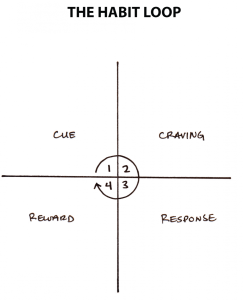Since the beginning of last year, I’ve made it my mission to switch as many household items to reusable as possible. It started simple, switching disposable Keruig pods, once I used up what I had, for a few reusable ones and switching out disposable round cotton pads (for your face) for some cloth ones. These were a few of the simple things that were easy to switch to when moving into college for the first time. But as I have moved into the Eco-cabin I’ve learned it’s not just about switching products from disposable to reusable, it’s also about changing one’s habits to a more sustainable one.
You might be asking yourself ‘How can one change their habits or where would I even start’. Let’s start by talking about what a habit is. Habits are a subconscious repeated manner that helps dictate some of the things we do in our day-to-day lives. Habits can range from small things like looking up when you hear a noise, to looking at your phone constantly when it pings. Habits are formed by four cues: number one is cue, which could be the pinging of your phone: number two is craving, now you crave to check your phone to see the notification: number three is response, now you pick up your phone to see the notification: number four is reward, now you are satisfied after looking into what the message was. These four cues all relate to James Clear’s model, The Habit Loop.

You now might be asking yourself how this relates to sustainability. Well, to become more sustainable one has to change their habits. For example, looking back at my Keurig example., When using disposable Keurig pods, I always felt guilty about throwing them away when I knew they could be composted and recycled. To fix this, I got reusable Keurig pods to satisfy my craving for having the ability to compost the coffee grounds and, if needed, recycle the Keurig pods. This is an example of fixing a small habit, something easily manageable to do in a short amount of time. But the bigger the habits that need changing, the harder and longer it takes to do. The new types of habits that I want to form require more time and patience, as well as starting to notice when the habits are in effect.
To create a good habit, we first need to know what our cue is. Finding out what are cue is will make it so we know when the habit will trigger into action. The second step is making the craving look attractive enough to break the old hold. The third step is making the response easy to change. Finally, the fourth step, making the reward to be satisfying. Combining all of these steps, from James Clear’s chapter, will allow you to start making new good habits. But with every good habit, there will always be some bad habits that need to be changed.
To make new habits have an effect, we might need to break a few old habits because they might counteract what your new habit might be doing. Like the previous times, we always start with cues and work our way down. To break a bad habit one must make their cue invisible, out of sight out of mind. Second, making the craving unattractive. Third, making the response difficult to do. Lastly, make the reward as unsatisfying as possible. Following these steps that James Clear has set up, will start you on a path to creating new sustainable habits.
If you having trouble starting new sustainable habits start with something small. For example, eating out less, going thrifting before buying new, buying in bulk instead of in small quantities, etc. Starting out small and seeing what you can accomplish is the best way to try to change some of your habits into more sustainable ones.
Sources:
Clear, James. Atomic Habits. Chapter 3, How to Start New Habits that Stick.
Duhigg, Charles. The Power in Habit. What we do in life and business
https://courses.furman.edu/pluginfile.php/760606/mod_resource/content/0/Habits%20book%20chapter.pdf
(Thank you Dr. Allen for showing this resource to SUS 120 last semester)
Image Source:
https://jamesclear.com/wp-content/uploads/2013/02/The-habit-loop-01-e1537283945960-971×1200.png